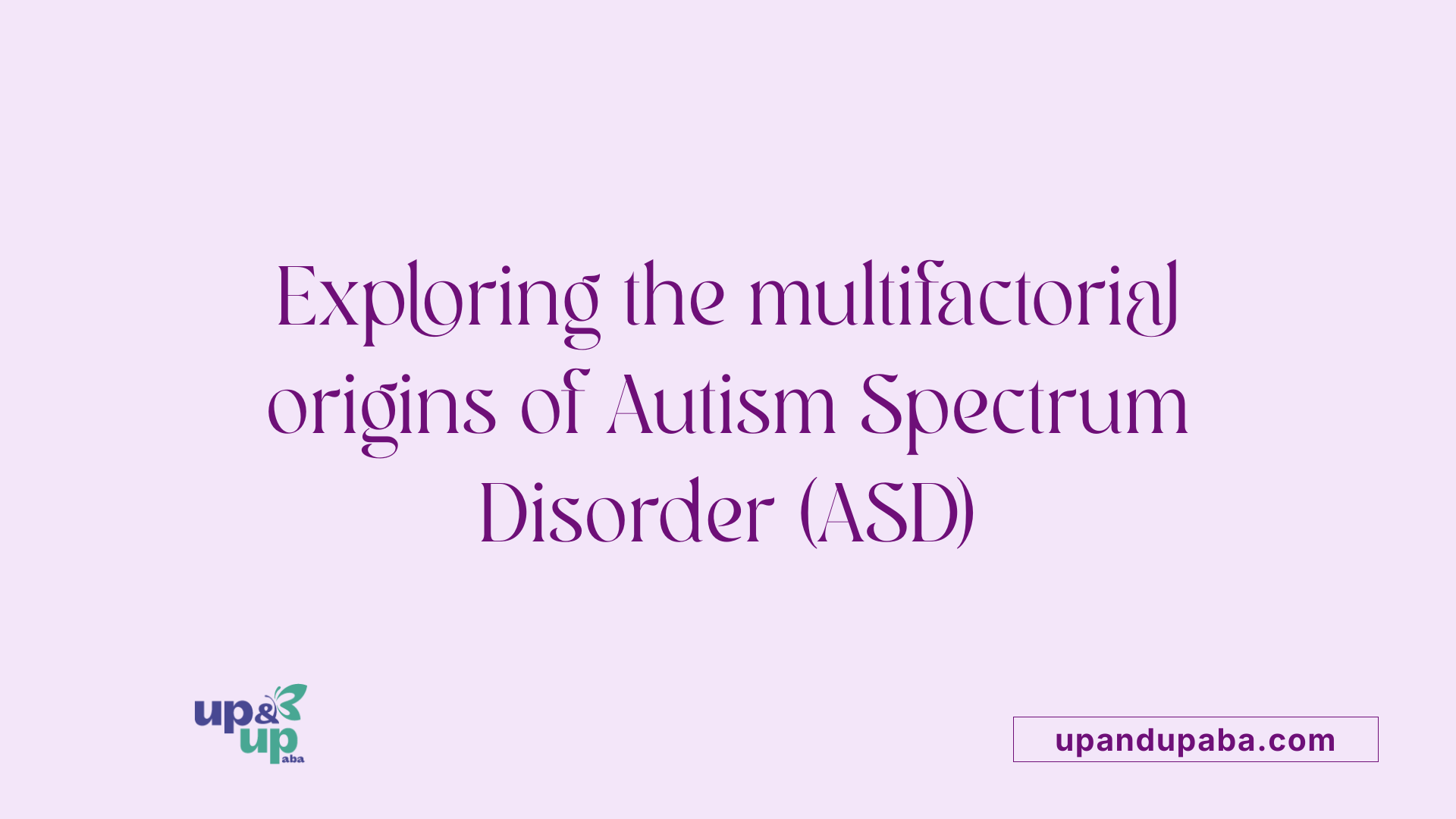Does Aluminum Cause Autism?
Exploring the Alleged Link Between Aluminum and Autism

Introduction to the Controversy
The idea that aluminum exposure, particularly through vaccines, might be linked to autism spectrum disorder (ASD), has been a topic of heated debate. While reputable health organizations maintain that vaccines are safe, some studies have suggested a potential correlation between aluminum levels in the brain and autism. In this article, we dive into the science behind aluminum exposure and its possible connection to autism, aiming to dispel myths and provide clarity on this topical issue.
Understanding Autism: Causes and Influences

What are the causes of autism?
The exact causes of autism spectrum disorder (ASD) remain elusive, but research underscores a multifactorial origin characterized by genetic, developmental, and environmental influences. Genetic factors play a crucial role, with heritability estimates for autism ranging from 60% to 90%. This implies a strong genetic component where families with one affected child have increased chances of ADD in subsequent children—about 1 in 5 for another child on the spectrum.
Advanced parental age, especially fathers over 45, can heighten the risks for ASD, alongside complications encountered during pregnancy like maternal infections or significant stress. However, no singular environmental trigger is conclusively linked to autism; it is a complex interplay of various influences that can lead to its development.
What are the environmental influences?
Although aluminum exposure in vaccines has been scrutinized, scientific reviews consistently reveal no credible evidence establishing a connection between aluminum adjuvants and ASD. Studies reviewed by organizations such as the CDC and WHO confirm that any aluminum present in vaccines falls within safe limits and does not correlate with autism traits.
Conversely, some research has shown cases of increased aluminum levels in the brains of individuals with autism compared to controls. Still, this correlation does not imply causation. Factors such as underlying genetic vulnerabilities or additional environmental components could be at play, highlighting the complexity of autism etiology.
What are the myths about vaccine links?
A persistent myth is that vaccines, particularly those containing aluminum adjuvants, contribute to autism. However, extensive research has consistently debunked this claim, with particular studies revealing no significant association between vaccination and ASD. The American Academy of Pediatrics stresses that the amounts of aluminum in vaccines are substantially lower than established safety thresholds, and the form of aluminum used is regarded as safe for immune response stimulation.
Despite concerns about aluminum as a neurotoxin or immune system disruptor, the vast majority of studies indicate that any risks are minimal when compared to the established benefits of vaccination in preventing serious diseases. Consequently, attributing autism to vaccines has been thoroughly disproven by rigorous scientific investigation.
The Role of Metals in Autism Spectrum Disorders

What is the link between metals and autism?
The concern regarding metals and autism spectrum disorders (ASDs) focuses on the adverse effects of toxic metals on neurodevelopment. Research has established that children with ASD frequently display elevated levels of metals such as lead, mercury, and aluminum. These metals can act as environmental risk factors, contributing to a variety of neurodevelopmental issues.
Toxic metals are known to cause oxidative stress, mitochondrial dysfunction, and neuroinflammation, all of which have been linked to the pathology of ASD. For instance, studies reveal that the presence of aluminum in the brain can disrupt neural pathways, suggesting a potential involvement in the development of ASD. The finding of significantly high aluminum levels in the brains of those diagnosed with autism warrants investigation into how these environmental pollutants interact with an individual’s genetic makeup.
Moreover, exposure to toxic metals like aluminum during crucial periods of brain development—often prenatally—has shown to have particularly harmful effects. Toxic metals can also interfere with the metabolism of essential metals, exacerbating symptoms. For instance, low levels of zinc, critical for various brain functions, can be further compromised in individuals exposed to toxic metals, intensifying the challenges they face.
Environmental Impacts of Toxic Metal Exposure
Despite concerns over aluminum adjuvants in vaccines, reputable health organizations like the CDC and WHO affirm the safety of aluminum levels associated with vaccinations. These organizations emphasize that the current scientific consensus dismisses credible evidence linking aluminum exposure, including that resulting from vaccines, to the development of autism.
This area remains controversial, with ongoing research focused on the broader implications of metals as environmental risk factors. Scientists are urged to further explore how their varying toxicities contribute to neurodevelopmental disorders, such as ASD, especially in vulnerable populations like children.
Assessing Aluminum's Impact on Children's Health
How does aluminum affect children?
High levels of aluminum can negatively affect children, particularly those with kidney disease. This demographic may experience aluminum accumulation in the body, leading to serious health concerns. While aluminum naturally exists in the environment and is ingested daily through food, excessive exposure can be problematic, especially for young children.
Dietary aluminum from foods and medications is usually harmless unless consumed in significant amounts. In general, the average daily intake of aluminum ranges from 7 to 9 milligrams, usually regulated and eliminated by the human body without causing harm. However, exposure to higher aluminum levels can be connected to brain and bone diseases in children with preexisting conditions.
Health implications of aluminum exposure
Concerns about aluminum exposure primarily arise from its connection to neuroimmune disorders and the potential link to autism spectrum disorders (ASD). Children, due to their developing physiology, may be more susceptible to the effects of aluminum than adults. Research indicates that exposure from vaccines, while carefully regulated, leads to questions about the cumulative aluminum burden on young patients.
Safe levels of aluminum
To mitigate risks associated with higher exposure, the federal government has established safe levels for aluminum in drinking water. Organizations such as the FDA and CDC maintain that the amounts present in vaccines are safe, reinforced by large-scale studies demonstrating no statistically significant correlation between aluminum exposure and autism.
| Topic | Description | Implication |
|---|---|---|
| Effects on Children | High aluminum levels can affect brain and bone health, especially in those with kidney issues. | Need for monitoring exposure. |
| Health Concerns | Potential links to neuroimmune disorders and ASD raise concerns regarding overall health and safety. | Calls for further investigation. |
| Safe Exposure Levels | Federal guidelines ensure aluminum in drinking water and vaccines is below known safety thresholds. | Emphasis on careful regulation. |
Investigating Aluminum Levels in the Brain
Studies on Brain Aluminum Content
Research has highlighted significant aluminum (Al) levels in the brain tissues of individuals diagnosed with autism spectrum disorder (ASD). Notably, brain samples from ASD patients showed aluminum concentrations averaging 3.82 μg/g in the occipital lobe, 2.30 μg/g in the frontal lobe, 2.79 μg/g in the temporal lobe, and 3.82 μg/g in the parietal lobe. Extremely high aluminum levels have also been recorded, such as 8.74 μg/g in a case involving a 15-year-old boy.
Furthermore, a large portion of control brain tissues displayed content below 1.0 μg/g, markedly less than those identified in ASD cases. The findings from various studies suggest that these elevated aluminum levels warrant further scrutiny regarding their potential implications for neurodevelopment.
Analytical Methods for Detecting Aluminum
To accurately assess the presence of aluminum in brain tissue, researchers have utilized sophisticated analytical techniques. Methods like transversely heated graphite furnace atomic absorption spectrometry and aluminum-selective fluorescence microscopy have been employed to measure aluminum concentrations effectively. These advanced techniques allow for detailed examinations of aluminum in relation to neuron health and behaviors in microglial cells, thereby shedding light on its possible implications in ASD.
Correlations Between Aluminum and Autism
While emerging evidence indicates potential correlations between aluminum exposure and ASD, the current consensus remains cautious. Several large-scale studies, including those published in well-respected journals, have found no significant links between aluminum in vaccines and autism. However, the ongoing exploration into the neurodevelopmental effects of aluminum raises important discussions within the scientific community. Despite certain studies showing correlations, the relationship remains complex, with other factors such as genetics and environmental influences also playing critical roles. Overall, this area of research is evolving, and further in-depth studies are essential to better understand the interplay between aluminum exposure and autism development.
Aluminum in Vaccines: Debunking Myths
Safety of aluminum in vaccines
Aluminum is commonly used as an adjuvant in vaccines to enhance the immune response. However, concerns have been raised regarding its safety, particularly its potential link to autism spectrum disorder (ASD). Despite these concerns, research shows that the amount of aluminum present in vaccines is significantly lower than what is deemed safe by the Centers for Disease Control and Prevention (CDC). The average daily intake of aluminum from all sources is around 7-9 milligrams, a quantity the human body efficiently regulates and eliminates without harm.
Assessment by health organizations
Reputable organizations, including the WHO, CDC, and the American Academy of Pediatrics (AAP), affirm that aluminum-containing vaccines are safe and effective. The U.S. FDA has also conducted thorough assessments, concluding aluminum levels in vaccines remain below regulatory thresholds, even for vulnerable populations such as low-birth-weight infants. They emphasize that studies claiming a link between vaccine aluminum and autism often lack scientific rigor and fail to establish causation.
Clarifying misconceptions
While some studies have indicated higher aluminum levels in the brains of ASD patients, this does not imply that aluminum exposure through vaccines is a direct cause of autism. Many scientists advocate that genetic predispositions and environmental factors are larger contributors to autism. Furthermore, experts highlight that intravenous solutions with aluminum, unlike vaccine formulations, should be monitored due to how aluminum is absorbed in the body, clarifying that concerns regarding vaccination safety are often misplaced.
| Topic | Findings | Summary |
|---|---|---|
| Meeting safety thresholds | FDA assessments confirm vaccine aluminum is below limits | Vaccines containing aluminum are safe for all, including vulnerable infants |
| Studies on aluminum and ASD | Mixed results and methodological flaws | Many studies found no significant link between aluminum exposure and autism |
| Regulatory stance | Strong endorsements from WHO, CDC, and AAP | Consensus that vaccines are both safe and effective in preventing disease |
Scientific Consensus and Expert Commentary
Views of health organizations
Reputable institutions such as the CDC, WHO, and the American Academy of Pediatrics (AAP) maintain that vaccines, which may contain small amounts of aluminum adjuvants, are safe and effective in preventing diseases. Their stance emphasizes the absence of credible evidence linking aluminum exposure, particularly through vaccination, to the development of autism spectrum disorder (ASD). The consensus is that the aluminum content in vaccines is well below the safety thresholds established by health authorities.
Expert opinions on aluminum in vaccines
Experts in the field, including Dr. Taison Bell, assert that the forms of aluminum used in vaccines have been extensively studied and found safe for stimulating an immune response. They argue that the context of its use in vaccines is crucial since the amount delivered is significantly lower than the daily aluminum intake, which averages around 7-9 mg.
Scientific studies on aluminum and autism
Numerous large-scale studies have investigated the relationship between aluminum exposure and autism, consistently finding no statistically significant correlation. For instance, analyses from the Journal of Autism and Developmental Disorders and the Journal of Child Neurology have reported no associations. A review by the Global Advisory Committee on Vaccine Safety highlighted flaws in studies suggesting links between aluminum and autism, affirming that observed correlations do not equate to causation due to the complexity of autism's origins.
Aluminum Exposure: Comparing Medical and Environmental Sources
Sources of Aluminum Exposure
Aluminum exposure can come from both environmental and medical sources. Common dietary sources include processed foods, baking powder, and some food packaging. Additionally, aluminum is present in drinking water and can stem from industrial emissions.
In medical contexts, particularly vaccines, aluminum adjuvants are used to enhance the body’s immune response. This has raised concerns about the cumulative aluminum exposure infants may receive from vaccinations.
Comparing Dietary Aluminum with Medical Exposure
While the average daily intake of aluminum from food is approximately 7-9 milligrams, medical exposure related to vaccines is significantly lower. Studies indicate that the volume of aluminum in vaccines is far below established safety thresholds set by the CDC and other health organizations.
Health Guidelines and Regulations
Health guidelines recommend careful monitoring of aluminum exposure, particularly in infants, due to their developing systems. The Global Advisory Committee on Vaccine Safety (GACVS) has emphasized that aluminum from vaccines remains well within safety limits, posing no credible risk of contributing to autism.
| Source | Type | Typical Exposure Levels |
|---|---|---|
| Dietary | Food and beverages | 7-9 mg/day |
| Medical (Vaccines) | Vaccine adjuvants | Much lower than dietary intake |
| Health Guidelines | CDC, WHO, AAP | Safe levels maintained |
Research continues into aluminum's impacts, reflecting the need for ongoing assessment of exposure from various sources.
The Ongoing Debate: Need for More Research
Current studies and limitations
In recent years, various studies have attempted to explore the connection between aluminum adjuvants in vaccines and autism spectrum disorder (ASD). While some research indicates higher aluminum levels in the brains of individuals with ASD, it remains essential to note that the majority of large-scale studies have not found a statistically significant relationship. For instance, findings from the Journal of Autism and Developmental Disorders and the Journal of Child Neurology concluded there was no meaningful association between aluminum and autism.
Research directions
Current research continues to delve into aluminum’s potential impact on neurodevelopment. Some hypotheses postulate that aluminum may disrupt immune system development, which in turn could affect brain development. Moreover, emerging studies are considering the interaction between aluminum exposure, gut health, and genetic predispositions to autism, suggesting a multifaceted approach to the issue.
Need for comprehensive investigation
Given the complexity of ASD and the variety of factors involved in its development, comprehensive investigations are warranted. Researchers must conduct well-structured studies that control for underlying genetic and environmental variables. Furthermore, understanding the full scope of aluminum's effects, particularly on susceptible populations such as infants, is crucial. The scientific consensus assures that vaccines are safe, yet continuous examination of all potential factors remains integral to advancing our understanding of ASD.
Conclusion: Where Do We Go From Here?
What Do the Studies Show?
Research has produced mixed results regarding aluminum adjuvants in vaccines and their relationship with autism spectrum disorder (ASD). Some animal studies indicate behavioral changes and elevated aluminum levels in ASD patients, raising concerns about potential neurotoxicity. Notably, a recent study demonstrated significantly high aluminum content in the brain tissues of individuals diagnosed with autism, with averages reaching 3.82 μg/g in the occipital lobe.
Are There Conclusive Connections?
Despite these findings, experts emphasize that correlation does not imply causation. Studies from reputable institutions such as the CDC and WHO maintain that the small amounts of aluminum used in vaccines are safe and effective, with no credible evidence linking them to ASD. Critically, larger studies have not found statistically significant associations between aluminum exposure and the development of autism.
What Should Parents Consider?
Parents are encouraged to stay informed through reliable sources. While research continues, the scientific consensus asserts that autism results from a mix of genetic and environmental factors rather than aluminum exposure from vaccination. For those concerned, discussing vaccination options with healthcare providers is essential.
Final Thoughts
While some studies have highlighted a potential correlation between aluminum exposure and autism, the research community and authoritative health organizations stress the lack of a definitive causal link. Vaccines, including those with aluminum adjuvants, remain crucial for preventing disease and are considered safe by experts worldwide. It is essential for ongoing research to clarify any potential risks aluminum exposure might pose to neurodevelopment, ensuring that health policies are informed by comprehensive, scientifically-backed evidence. As the debate continues, fact-based, measured discourse remains key to safeguarding public health and enhancing our understanding.
References
- Reviewing the association between aluminum adjuvants in the ...
- Aluminium in brain tissue in autism - ScienceDirect.com
- Does Aluminum Cause Autism? - The Treetop ABA Therapy
- Aluminum, mercury in vaccines not linked to autism | Fact check
- Adjuvants - World Health Organization (WHO)
- Aluminium in human brain tissue from donors without ... - Nature
- Aluminum and Autism: Seeking Clarity Amidst the Controversy
- Autism Spectrum Disorders and Aluminum Vaccine Adjuvants



